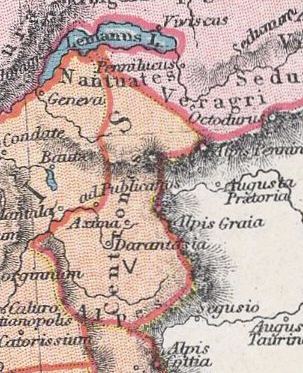 | ||
The Ceutrones (variant: Centrones) were a pre-Roman Celtic tribe of ancient Gaul that controlled the Graian Alps regions of Gallia Viennensis Quinta in Gallia Narbonensis.
Contents
History
According to d’Anville, the Ceutrones occupied most of the Tarentaise Valley in the modern department of Savoie, France. Pliny the Elder called them "borders," that is, people living on the western border of the Alps. Ptolemy places them in the Graian Alps occupying the regions west of the Aosta Valley inhabited by the Salassi.
The Ceutrones had a sizeable population readily willing to defend themselves, probably with well cultivated lands, according to written accounts by great armies that passed through. Polybius describes how the Ceutrones aggressively attacked Caesar’s army on its march through the Alps to Lake Bourget. The onslaught included by an assault by rolling rocks and stones in the mountainous passes, and inflicted great losses of life on the Roman forces. Polybius also describes a meeting by envoys of the Ceutrones with Hannibal.
The Ceutrones are mentioned by Caesar (Commentarii de Bello Gallico, 1.10):
... Here (in the Alps) the Ceutrones and the Graioceli and the Caturiges, having taken possession of the higher parts, attempt to obstruct the army in their march. After having routed these in several battles, he arrives in the territories of the Vocontii in the Further Province on the seventh day from Ocelum, which is the most remote town of the Hither Province; thence he leads his army into the country of the Allobroges, ...A Roman inscription about the Ceutrones from Axima (Aime) has survived.
Settlements by the tribe were identified by Ptolemy in his Geographia, and some appear on the Tabula Peutingeriana. One of the most important cultural centers was Darantasia, which gave the Tarentaise Valley and region its name. Medieval clergy made this city an important religious center before the end of the first millennium. They called it Monasterium, which became Moûtiers, by which it is now known.
The village of Centron in Montgirod, Savoie, likely the place known as Forum Claudii Ceutronum under the Romans, preserves the tribal name.
Several tribes were immediate neighbors of the Ceutrones and occupied territories that partly overlapped with theirs. These include:
